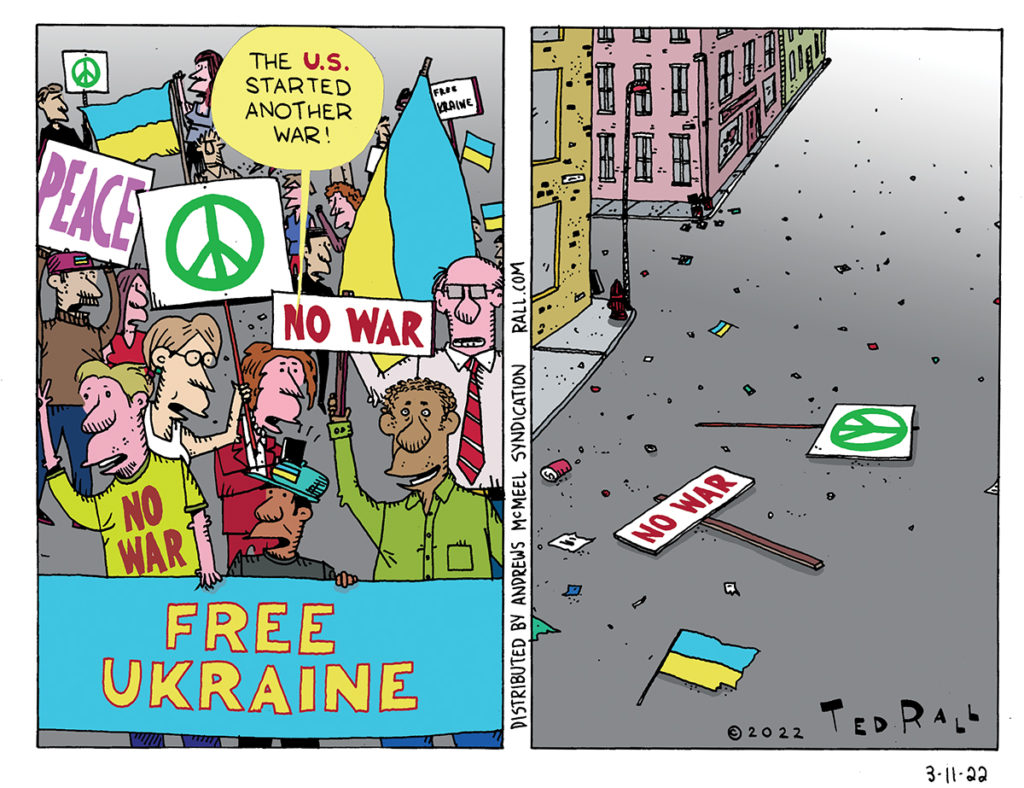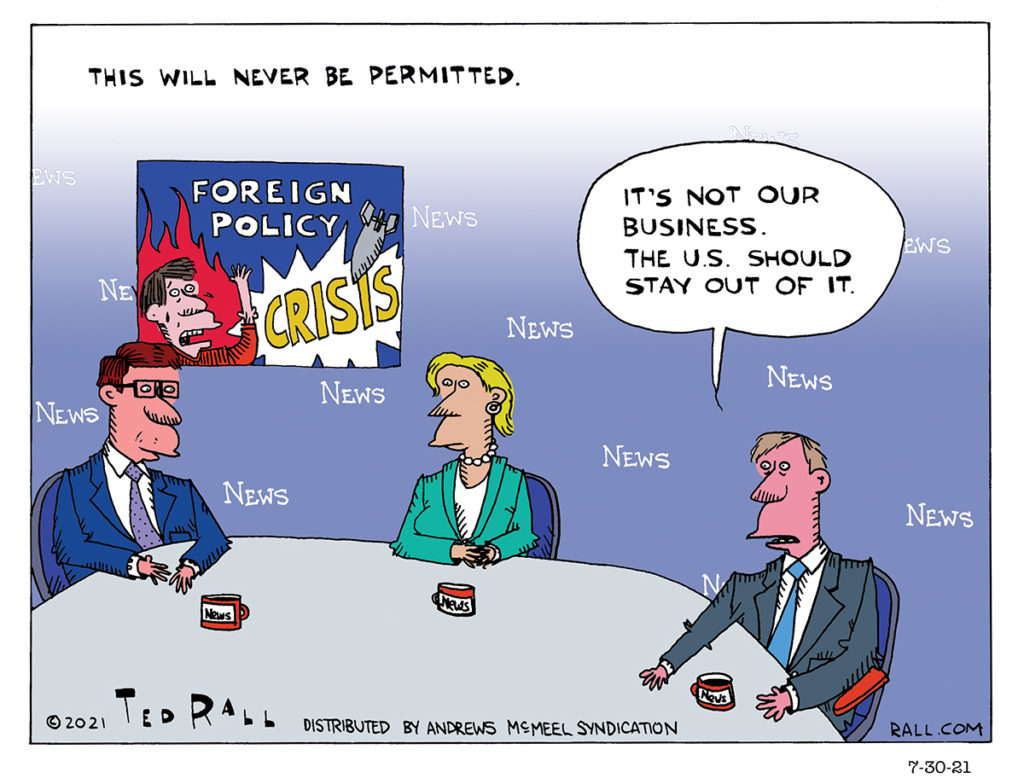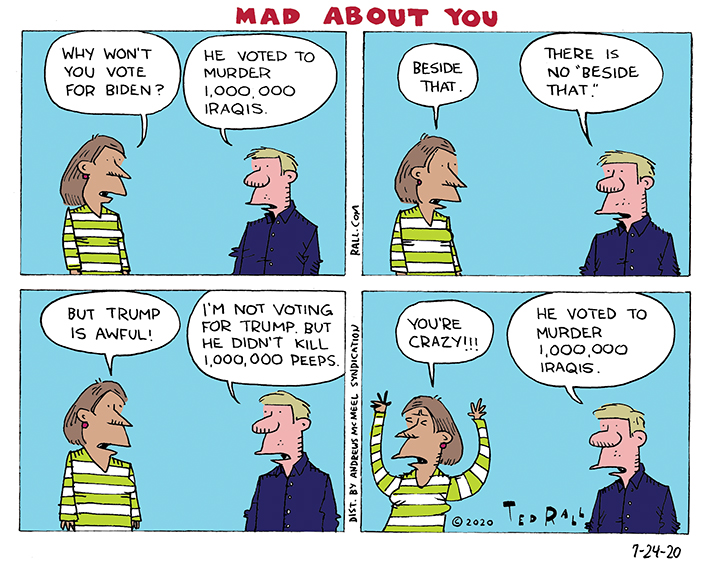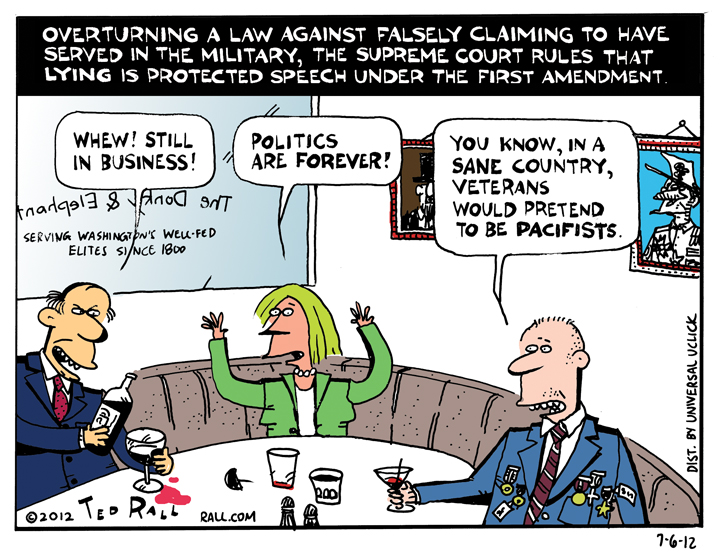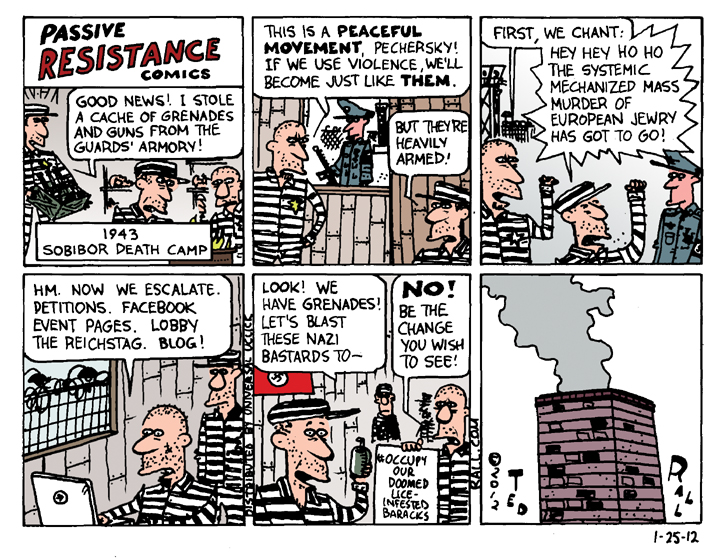Many Americans, both Democrats and Republicans, are protesting angrily about Russia’s invasion of Ukraine. But the peaceniks-come-lately were nowhere to be found over the last two decades as the United States invaded Afghanistan and Iraq, waged a brutal proxy war in Yemen and Syria, destroyed Libya and terrorized much of the world with assassination drone planes. When the US is the guilty party, citizens of the US are silently complicit. The hypocrisy is breathtaking.
No Pacifists Allowed on News Shows
Ever notice how, when there is a foreign policy crisis, the discussion is always between intervention and more intervention? There’s never anyone at the table on TV news discussion shows who is a pacifist who is simply is against war, or even someone who suggests that this particular crisis is something the US ought not to be involved in.
SYNDICATED COLUMN: Pacifist America
Antiwarriors Are Citizens Without a Party
Americans overwhelmingly oppose the wars against Afghanistan and Iraq. Even many veterans say the post-9/11 war on terror was a mistake.
Antiwar sentiment is the majority opinion when it comes to the prospect of future conflicts. Of the two countries the U.S. is currently most likely to attack militarily, nearly seven out of ten people are against invading Syria; even polls that ask leading questions (“do you favor a military strike to prevent Iran from acquiring nuclear weapons?”) find public opinion running opposed to attacking Iran, by 52% to 41%.
Not only are most Americans against wars present and future, we want to slash defense spending in general. According to a National Journal poll, 60% want to cut the Pentagon budget. Thirty-five percent don’t.
Eleven years after America lost the Twin Towers and then its collective mind, something remarkable has happened. We’ve come to our senses.
We’re a nation of pacifists.
So how is a pacifist—in other words, an average American—supposed to vote this fall? Obviously not Republican: Romney says he’ll cut every department except Defense. He wants to spend more on weapons, is open to fighting against Afghanistan and Iraq indefinitely, and is so ignorant that he doesn’t know that the people of Afghanistan are called Afghans.
But with all the veteran and war messaging that went on at last week’s national convention, Democrats look like a mirror image of the GOP: jingoistic, militaristic, and gung-ho for war. Between pogo-dancing on Osama bin Laden’s corpse, the airing of a mawkish “Honoring the Sacred Trust with Our Veterans” video that spread the debunked right-wing myth that returning Vietnam vets got disrespected, the First Lady donning a Dubya-inspired “support our troops” T-shirt, and Democrats’ petty attack on Mitt Romney for omitting to name-check vets in his nomination acceptance address, it felt like the 2002-03 build-up to the invasion of Iraq—except, this time, the president speaks fluent English.
It’s official: the Dems are a war party.
Why the new bellicose tone? In part it’s an attempt to counter the old canard that Democrats are weak on defense, a charge that Republicans used to their electoral advantage throughout the Cold War. As the probably doped Lance Armstrong advised, turn your biggest weakness into your strongest strength. (The Machiavellian Karl Rove, who attacked John Kerry’s war record of all things, put it the other way around: turn their biggest strength into their biggest weakness.) It’s also a reflection of the triumph of Democratic Leadership Council-inspired conservatives, who have cowed, purged and marginalized liberals and pacifists from the party.
Militarism may be unpopular, but it still rules the ruling class. The military-industrial complex enjoys more direct political and economic influence among government officials than ever. The post-9/11 Cult of the Noble Soldier, coupled with the myth of a beleaguered U.S. defending the world from barbarians in an epic clash of civilizations, merely recasts old-fashioned fascist militarism—and it’s just as effective at confusing leftie opponents and putting them off-balance.
Truth be told, the Democrats’ new hawkish tone is catching up with their party’s hawkish history. Ronald Reagan gets credit for the defense build-up of the 1980s that supposedly bankrupted the Soviet Union, but it was Jimmy Carter who started it in 1978. No one remembers now, but “wimpy” Carter also gave us draft registration (in response to the Russian invasion of Afghanistan). Mr. Habitat for Humanity sent arms to the Afghan mujahedeen (some of whom formed Al Qaeda) and provoked the Iran hostage crisis by admitting the recently deposed Shah to the U.S. Bill Clinton launched an optional war of choice against Serbia based on sketchy justifications, and waged an incessant aerial bombing campaign against Iraq that went on so long that the media got bored and stopped covering it, and U.S. pilots ran out of targets.
President Obama may not have been popular with the SEAL team he sent to assassinate bin Laden, but thousands of Pakistanis, Afghans, Yemenis and Somalis victimized by the reign of terror unleashed by his unprecedented, expanded program of drone plane bombings can attest to his credentials as a happy warrior. “Barack Obama,” Aaron David Miller, Middle East policy adviser to Republican and Democratic administrations, wrote recently, “has become George W. Bush on steroids.”
Democrats have always been pro-war. They’d might as well shout it from the rooftops.
Most Americans are against the wars in Iraq and Afghanistan, the cult of militarism and the untouchable status of Pentagon spending on weapons. Yet there is no political home for people who oppose our current wars, or war in general.
Where is a pacifist to go?
(Ted Rall‘s new book is “The Book of Obama: How We Went From Hope and Change to the Age of Revolt.” His website is tedrall.com. This column originally appeared at NBCNews.com’s Lean Forward blog.)
COPYRIGHT 2012 TED RALL
SYNDICATED COLUMN: Occupy Wall Street – What Comes Next?
Things Have Changed. Time to Adapt.
The Occupy National Gathering, held July 1-4 in Philadelphia, perfectly captures the current state of Occupy Wall Street.
First, the cops pushed the Occupiers around, refusing them space in Independence Park. They wound up in Franklin Square. (Just like old times. In September 2011 Occupiers found Wall Street blocked off by the NYPD. Zuccotti was ad hoc option two.)
Second, the Philly confab was wimpy and watered-down. When one of your honored guests is Daryl Hall of the 1980s duo “Hall & Oates,” militancy is probably off the menu.
Third, the Occupiers weren’t really Occupiers (though many no doubt didn’t know that they’d been coopted by Democratic Party operatives). ONG was yet the latest attempt by front groups set up by MoveOn.org in order to channel the energies of the OWS movement into the Obama reelection campaign.
“What’s going on with Occupy?” people ask me. “We don’t hear anything about them anymore.” By which they mean, they haven’t seen or read anything about OWS in the corporate media. They also probably haven’t “heard” about the enormous street protests in Montreal, which routinely draw 400,000 to 500,000 people, or about Bill 78, a law passed by Quebec’s parliament that suspends the rights of free speech and assembly, which has transformed the province into a police state, or that the real unemployment rate—the way it was calculated before 1980—is 23 percent.)
When your media is this far gone, you don’t “hear” much.
Some say Occupy is dead. Others disagree. “Occupy Will Be Back,” liberal writer Chris Hedges wrote recently.” It is not certain we will win. But it is certain this is not over.” (I don’t know who this “we” is. As far as I’ve heard, the squishy former New York Times journo’s role at Occupy has been limited to book-shilling.)
As a person who helped plan the event that initially sparked OWS; as one who was thrilled by its instant popularity, potency and potential; as someone who participated in the branch of OWS in my own community through the winter, including direct action confronting the authorities—and as a long-time student of historical crises and revolutionary movements—I think it’s less important to guess whether Occupy has a future than to examine how a movement with widespread public support from left and right alike devolved from nearly 2000 public encampments to its current situation: marginalization and cooption.
That said, this summer offers good opportunities for OWSers to make some noise. Occupiers will protest the two major party conventions later this summer. The longer the campaign goes on without either candidate seriously engaging jobs and the economy—hands down the most important issue in Americans’ minds—in a credible way, the more removed from reality the political horserace and its media carnival barkers become, the longer the suffering goes on (and suffering, we sometimes forget, is cumulative, each pain and setback exponentially building upon the last), the more appealing Occupy, or perhaps some more aggressive successor, will be.
Whether the first major street movement since the 1960s survives, grows or metastasizes, we must learn the lessons of Occupy’s first year.
Like every political system, every movement contains the seeds of its future demise. OWS began with an unsustainable premise: occupy public space, yet remain nonviolent. What happens when the cops show up? You leave peacefully. Game over. Which, with the exception of Occupy Oakland—an interesting exception, insofar that clashes with the police increased popular support—is what happened everywhere from lower Manhattan to City Hall Park in Los Angeles.
Occupy should have permitted resistance, violent and/or nonviolent. That, or it shouldn’t have camped out in parks in the first place. Similar movements, in Spain and Russia for example, operate out of offices and churches and use flash-mob tactics to carry out hit-and-run direct actions against banks and other targets. If you’re going to make an Alamo-like stand, well…make a stand.
As I and just about everyone else pointed out at the time, moreover, camping out in the cold sucks. A dumb tactic for a movement that began in the fall and intended to last indefinitely.
Occupy has been overly inclusive. As a reaction to and rejection of the two big corporate-backed political parties, OWS was inherently radical. Yet for week after week, month after month, General Assemblies all over the country have been disrupted and hijacked by liberals, Democrats, and other traditional partisans who don’t share the OWS ideology of non-partisanship and non-affiliation with Ds or Rs, and militant resistance to their backers, the banksters and other corporate hucksters.
Others have criticized OWS’ unwillingness and/or inability to issue a list of demands. Not me. I have seen how the debates within Occupy have empowered voiceless men and women who used to think politics was for politicians. It was—is—powerful.
Let the oppressors try to guess how we may be mollified, how they might avoid revolution. Demands, we believed, would define us too narrowly and separate us from one another.
But things have changed.
We have been kicked out of our encampments. Occupy groups in numerous cities have split into radical and reformist (liberal and/or Democratic) factions.
There really is no place for the liberals within Occupy. Democratic apologists should go where they belong, to volunteer for Obama, to waste their time and money on the torturer of Guantánamo, the drone murderer of Waziristan, he who golfs while the 99% watch their wages shrink and their homes taken away, he who extended his “good war” against Afghanistan through 2024.
We real Occupiers, we radicals, should come together around a list of demands that define us, and allows the wait-and-see public what we’re about, to understand that we are fighting for them—demands that a somewhat reasonable and responsive government would agree to, but cannot and will not because it would counter their insane, addictive greed, their lust to control and own everything, everywhere, everyone.
They even trademark the germs.
There should be demands for justice: prison sentences and fines for the politicos and corporate executives of those whose behavior was not only reprehensible but illegal, along with the seizure of their companies and their properties for the public good. One would start, naturally, with the President.
There should be demands for redress: payments and other material compensation for those who were the victims of crimes, economic and otherwise. Torture victims need counseling and homes, and deserve punitive and compensatory damages; those who lost their homes to illegal foreclosures need not only their old lives back, but also interest and cash penalties to serve as a deterrent to those tempted to engage in such behavior again; the same goes for those who rotted in prison for non-criminal “crimes” like using drugs.
And there should be demands for systemic changes: opening up ballots to third parties; making it illegal for elected representatives to talk to businesspeople, much less accept contributions from them; rigorously enforcing the constitution, laws and treaty obligations so that, for example, Congress gets back the exclusive right to wage war; expanding the Bill of Rights to include such obvious 21st century necessities as a right to a college education should a citizen desire one, a right to a living wage that doesn’t depend upon the whims of local employers, and a right to be treated for any illness, without charge, just because you’re American and you live in the wealthiest society that has ever existed, anywhere.
(Ted Rall’s new book is “The Book of Obama: How We Went From Hope and Change to the Age of Revolt.” His website is tedrall.com.)
(C) 2012 TED RALL, ALL RIGHTS RESERVED.
Every Lie is Sacred
In a little-noticed ruling issued concurrent to the Affordable Care Act, the U.S. Supreme Court overturned the Stolen Valor Act, which made it a crime to lie about having served in the military. Which made me think, (a) who’d want to admit they were in the military if they had been, much less brag about it if they hadn’t, and (b) politicians must be grateful now that their favorite activity–lying–has been deemed worthy of First Amendment protection.
SYNDICATED COLUMN: Next Memorial Day, Remember America’s Victims Too
Self-Delusion and the Cult of Militarism
Memorial Day: our national celebration of charred meat (but the four contractors hung from that bridge in Iraq don’t count).
Hope you enjoyed the weekend.
However, as we begin the countdown to next year’s Warapalooza—only 362 more days before you fire up the grill or, if someone near and dear died in one of our wars, spend the day at the graveyard grumbling about the fact that too few Americans share your sacrifices—I’d like what’s left of the Left to stop missing a golden opportunity to protest, mock and undermine the cult of militarism.
Let’s make Memorial Day 2013 a day to remember all the victims of American warmongering. By all means, shed a tear for the 58,282 American men and women who died for transnational natural gas corporations during the 1960s and 1970s, and a patently absurd “domino theory” in Vietnam. But make sure you cry 35 times more for the 2,000,000-plus Vietnamese men and women our soldiers were sent to kill—people who posed no threat to us, who did us no harm.
Let’s build a wall for America’s war victims in Washington. It’s the least we could do.
That sucker would be big. Huge. Big enough to stimulate the local construction economy.
Hang a flag and place a flower on the grave of one of the draftees too clueless or afraid to evade service, of a rube so ignorant of history and politics that he enlisted to fight in one of our countless optional wars of illegal aggression, of a bloodthirsty thug who seized the chance to commit murder for the state. They were our brothers and sisters and sons and daughters, and we loved them. We miss their unfinished lives.
Our war dead deserve recognition for helping to expand the American empire, and for lining the pockets of the profiteers and their pet politicians.
But worry not: the right-wingers will never let us forget these heroes.
Those of us who stand on the Left have a different duty. We stand for the oppressed, the downtrodden, the abused. We defend the innocent. We care about the underdog.
We on the Left reject the idea of The Other. To us, no life has more or less meaning or value than any other life. Our dead or not worth more than “their” dead. There is no us and them, there is only us.
Her death is not counted by the Obama Administration; still, we mourn the Yemeni woman blown to bits in a Predator drone strike on her home as much as the young man from North Carolina who goes up in an IED blast in Helmand province.
And so we, the Left, ought to declare that Memorial Day 2013 should belong not just to the jingoists and war criminals and patsies, but also to their victims. We should hang banners and march on behalf of the hundreds of thousands of Iraqis and Afghans murdered by U.S. forces since 2001. Call 1-800-Flowers; ask them to deliver a bouquet to a cemetery in Fallujah.
I’m not a pacifist. Some wars—a few wars—must be fought. Invading armies must be resisted.
But not most wars. War is almost always a struggle of the rich and powerful fought by the poor and powerless. War kills, maims, and makes people crazy. It destroys infrastructure. It sucks away resources—money, technology, people—that would be better deployed somewhere else.
Most Americans know this—or they think they do. On a gut level, however, we’re sheepish and embarrassed about the crimes committed in our name. We’re in denial.
It’s understandable. We’re not insane. We’re in a state of cognitive dissonance; we want to be one thing—peace-loving, good people—but we know we’re the opposite—passive, tolerant and fearful of “our government” (which not only can assassinate any one of us at any time, for any reason, but actually asserts the legal right to do so as consistent with the democratic values to which we supposedly adhere).
“Our” leaders feed us mass delusion. “You came home and sometimes were denigrated, when you should have been celebrated,” President Obama told a group of Vietnam vets on the occasion of the 50th anniversary of the start of the war. “It was a national shame, a disgrace that should have never happened.”
And it didn’t.
As historians have proven, no one ever spat on a soldier returning from Vietnam. To the contrary: the antiwar movement was pro-vet (in part because so many servicemen were conscripts). The spat-on-vet story began circulating after—of all things—Sylvester Stallone’s character in “Rambo 2” talked about it. Obama knows, or should know, the truth. He’s old enough to remember.
“You persevered though some of the most brutal conditions ever faced by Americans in war,” Obama went on. “The suffocating heat. The drenching monsoon rains. An enemy that could come out of nowhere and vanish just as quickly.” Why was the weather so tough, the enemy so fierce? Obama left that, along with much else, unsaid: we were invaders and occupiers, half a world away, propping up tyrants in a place where we had no business whatsoever.
And finally, an outrageous claim, one so widely accepted that the media didn’t bother to quote it in news accounts, much less question it: “We hate war. When we fight, we do so to protect ourselves because it’s necessary.”
What a kidder!
We Americans have fought a handful of battles, much less entire wars, to “protect ourselves.” From the Barbary States to Latin America and Cuba to Grenada and Panama and Pakistan and Somalia and Afghanistan and Iraq, the United States military has attacked without just cause, without legal justification, with impunity, 99 percent of the time.
It’s bad enough to live in a nation in thrall to the cult of militarism. It’s worse to lie about it. And it’s insane to believe the lies.
(Ted Rall’s next book is “The Book of Obama: How We Went From Hope and Change to the Age of Revolt,” out June 5. His website is tedrall.com.)
COPYRIGHT 2012 TED RALL
SYNDICATED COLUMN: The Occupier’s Choice: Violence or Failure
Don’t Know What They Want, But They Know How To Get It
Here’s how U.S. state-controlled media covered events at Occupy Oakland:
“A day of demonstrations in Oakland that began as a significant step toward expanding the political and economic influence of the Occupy Wall Street movement, ended with police in riot gear arresting dozens of protesters who had marched through downtown to break into a vacant building, shattering windows, spraying graffiti and setting fires along the way,” reported the AP.
Then they quoted an Occupy Oakland member: “‘We go from having a peaceful movement to now just chaos,’ said protester Monique Agnew, 40.”
The lede of this November 3rd AP story frames a larger narrative. “Political and economic influence” cannot be achieved through violence. Ms. Agnew’s quote is used to support that framing. The move from “peace” to “chaos” represents a setback for the Occupy movement.
Violence = tragedy.
Considering that recorded history does not include a single instance of a nonviolent movement effecting radical change, it is interesting that anyone would argue that violence is by definition a negative development. It is equally astonishing that anyone would believe it.
In a revolution, one set of elites gets supplanted by another. There has never been a nonviolent revolution.
Never.
Gandhi was nonviolent. But his allies did resort to violence on numerous occasions. And India wasn’t a revolution. It was an independence struggle. The rich remained rich; the poor stayed poor. Conversely, there has never been a revolution in which violence was the primary tactic. Even the bloodiest revolutions—France, Russia, China—relied more on national strikes, sabotage, marches and demonstrations than shooting people. Revolutions are mostly nonviolent. But violence must always part be of the revolutionist’s toolkit.
Movements move.
Sometimes against the will of many of its members, the nascent Occupy movement is being propelled forward into its second phase: increasingly direct confrontation with the security apparatus of the American police state. The consideration of violence as a tactic is the inevitable result of Occupy’s own internal logic, resulting from a combination of its timing—at a time when revolution is needed and desired by millions of Americans, it’s the only insurrection in town—and its leaderless structure.
Never in history have the wealthy or powerful voluntarily relinquished substantial amounts of money or power. The corporate elite and the political class that enables them—the “1%,” as Occupy calls them—will never give into the Occupier’s demands to reduce their power or wealth unless faced with violence or the credible threat thereof.
As Peter Gelderloos writes in his book How Nonviolence Protects the State: “Time and again, people struggling not for some token reform but for complete liberation—the reclamation of control over our own lives and the power to negotiate our own relationships with the people and the world around us—will find that nonviolence does not work, that we face a self-perpetuating power structure that is immune to appeals to conscience and strong enough to plow over the disobedient and uncooperative.”
If voting or writing letters to the editor worked, we wouldn’t need Occupations.
The Occupy movement can wind up in one of two ways:
Failure.
Or success, partly via the occasional use of violence and/or the credible threat of violence that results from those sporadic outbursts.
First let’s define terms. Vandalism, theft and destruction of property are not violence. Inanimate objects do not suffer. Violence can only be inflicted upon living beings. Breaking a window may or may not be morally justified, but it is never violence. Further, violent self-defense is not the same as violence. Until now the violence at the Occupations has all been initiated by the police. When policemen fire rubber bullets, bean bags, tear gas and pepper spray at unarmed, peaceful protesters, their victims have every right to defend themselves—to run away, to avoid arrest and yes, to strike back.
Every civilized society recognizes the right to self-defense.
Perhaps because they were retroactively spooked by the bombings, bank robberies and kidnappings that marked the disintegration of the Vietnam protest movement, throughout the last 40 years American leftists have adhered to a strict code of militant nonviolence. Abandoning the tactics of disruption and non-cooperation (both of which were central to Gandhi’s approach), demonstrators’ ridiculous cooperation with government authorities reduced progressivism to farce.
Marchers apply for permits on public streets. Organizers give the police pre-printed lists, last name first, of activists who volunteer to be arrested; they are quickly booked and released, rarely less than $100 poorer. It is theater, a mere pantomime of genuine protest.
And it never works. You need only look back at the political history of the United States between 1971 and 2011 to see what 100% nonviolence has accomplished. Even under Democratic presidents and Congressional majorities, the Left has lost one battle after another.
The Left’s only major victory during that period followed the 1999 Battle of Seattle. Riots and broken windows disrupted the World Trade Organization for years. Countless American jobs were saved as a result. Yet liberals were ashamed.
Violence! How terrible!
Not as terrible as the wars and the massive unemployment, apparently.
At the core of the cowardice of protests carried out by establishment liberals has been slavish adherence to nonviolence at all cost. At most protests over the past few decades self-appointed “peace police” patrol the edges of crowds penned into “free speech zones” (which are inevitably placed out of the way, far from cameras). The peace police don’t lift a finger to protect demonstrators against police brutality. Instead, they act to prevent protesters from doing anything to “provoke” the cops, even when they are trying to protect themselves from brutality.
What makes the Occupy movement different and so compelling is that it moves beyond going-through-the-motions toward real resistance against tyranny for the first time since the 1960s. Seizing territory without a permit and refusing to relinquish it, as has happened at Occupy Wall Street and hundreds of other cities, presents an inherent threat to the system. The authorities can’t win no matter what they do.
They can’t do nothing. Tolerance signals legitimacy, even tacit approval of OWS and their message that rich individuals and big corporations have too much wealth and control over us. Can’t have that. Rupert Murdoch’s house organ, the New York Post, ran a front-page editorial on November 3rd screaming: “Enough!”
But crackdowns make the movement grow even bigger. A video of a NYPD official pepper-spraying four women at OWS without provocation inflamed public opinion and drew more people to Manhattan’s Zuccotti Park. An announced plan to evict OWS was scrapped after hundreds of people traveled there to gird for battle.
Speaking for New York’s business community as well as Murdoch, the Post editorialized: “Time’s up. The Zuccotti Park vagabonds have had their say—and trashed lower Manhattan—for long enough. They need to go. Be it voluntarily—by packing their tents and heading off in an orderly fashion. Or by having the NYPD step in—and evict them.” They blame OWSers for urinating outside. Which merely reminds New Yorkers how unresponsive their government is: there are no public restrooms in Manhattan.
You can smell the fear along with the pee.
Meanwhile, as politicians feel more pressure to crack heads, Occupations will have to move indoors. Freezing temperatures have arrived in New York and much of the country. Tensions will rise. As clashes with the authorities intensify, the ridiculous fetish of nonviolence—a faith-based tactic with no more basis in historical fact or reality than creationism—will be forgotten and, one day soon, laughed at.
(Ted Rall is the author of “The Anti-American Manifesto.” His website is tedrall.com.)
COPYRIGHT 2011 TED RALL

